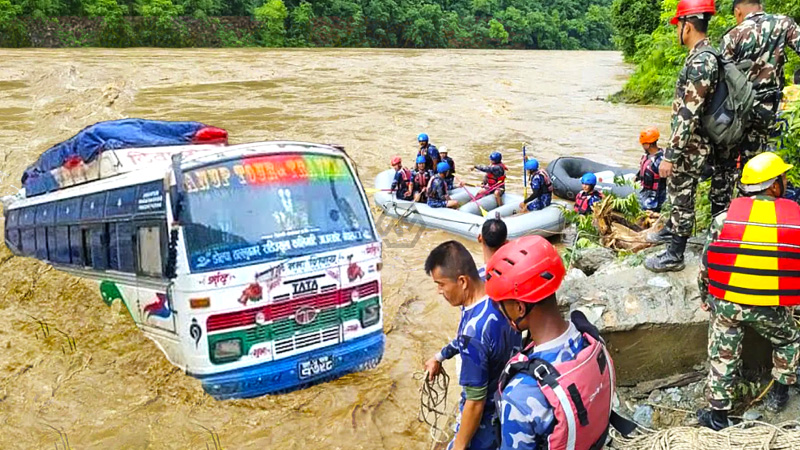- Two buses with at least 60 people swept into Trishuli River by a landslide.
- Three survivors swam to safety; ongoing rescue efforts hampered by rain.
- Another landslide nearby killed the driver of a third bus; family of seven also killed in Pokhara.
A landslide in central Nepal early Friday swept two passenger buses into the Trishuli River, leaving at least 60 people unaccounted for. Rescue operations, involving police, army personnel, and scuba divers, are underway despite being hindered by continuous rainfall and additional landslides.
The buses were traveling on a key highway linking the capital, Kathmandu, to southern Nepal when the incident occurred near Simaltal. Heavy monsoon rains in recent days have swollen rivers, making rescue efforts more challenging.
Monsoon Landslides Devastate Nepal, Rescue Efforts Underway
Early Friday, two passenger buses carrying at least 60 people were swept into Nepal’s Trishuli River by a landslide, resulting in a major search and rescue operation. Continuous heavy rainfall has caused rivers to swell and landslides to become more frequent, complicating the rescue efforts. Despite these challenges, rescuers, including police, army personnel, and divers with scuba gear, are diligently searching for the missing buses and passengers.
The incident occurred around 3 a.m. near Simaltal, approximately 120 kilometers west of Kathmandu. The buses were traveling on a crucial highway connecting the capital to southern regions of Nepal. The three survivors, who managed to swim to safety, are receiving medical treatment. They reported that more passengers might have boarded the buses en route, suggesting the actual number of missing people could be higher.
In a related tragedy, a third bus was struck by another landslide on the same highway, killing the driver. Additionally, a family of seven was buried by a landslide near Pokhara on Thursday night while they were asleep in their hut. These incidents underscore the severity of the monsoon season in Nepal, which frequently triggers landslides and flooding across the mountainous terrain.
Nepal’s Prime Minister, Pushpa Kamal Dahal, expressed his sorrow over these events and highlighted the ongoing rescue efforts by various government agencies. The monsoon season, lasting from June to September, poses a significant threat to the region, often resulting in devastating landslides and floods. As the rains continue, the risk of further incidents remains high, prompting heightened alert and preparedness among the authorities and local communities.
The recent landslides in Nepal highlight the urgent need for enhanced disaster preparedness and response measures. As the monsoon season continues, the priority remains on rescuing the missing and safeguarding vulnerable communities from further devastation.
“The monsoon season, lasting from June to September, often triggers landslides in the mountainous Himalayan country.”



